- Calcium and bones - (https://medlineplus.gov/ency/article/002062.htm)
- Treatment of osteopenia - (http://www.ncbi.nlm.nih.gov/pmc/articles/pmc3411311/)
- Treatment for bone disorders focuses on strengthening bones, slowing bone loss - (http://newsnetwork.mayoclinic.org/discussion/tuesday-q-a-treatment-for-bone-disorders-focuses-on-strengthening-bones-slowing-bone-loss/)
- Osteoporosis and osteopenia - (http://mpkb.org/home/diseases/osteoporosis_osteopenia)
- Osteopenia - (https://en.wikipedia.org/wiki/osteopenia)
What is Osteopenia?
Osteopenia refers to bone density that is lower than what is required. Bone density is a marker of how dense and strong the bones are. Osteopenia increases the risk of osteoporosis; but not everyone with osteopenia will develop osteoporosis. To be specific, osteopenia is a bone mineral density T-score between -1.0 to -2.5. T-score is the number of units (standard deviations) that your bone is above or below the average.
Osteopenia results in bone fragility and increases your risk of fracture. It is also a warning sign that you should take steps to prevent osteoporosis and avoid any fractures in the future.
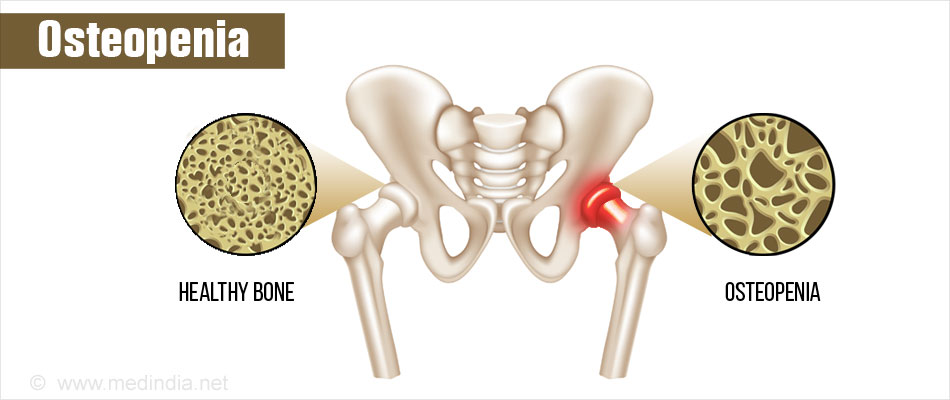
Osteopenia vs Osteoporosis: What is the Difference?
Osteopenia and osteoporosis are both conditions in which the bone density is below normal.
| Osteopenia | Osteoporosis | |
| Overview | Bone loss is less severe | Bone loss is more severe |
| T-Score | Between -1.0 and -2.5 | Less than -2.5 |
| Fracture | Less likely to fracture a bone | More likely to fracture a bone |
What are the Causes of Osteopenia?
Osteopenia can be due to many factors which affect the density of bone, such as:
- Osteopenia is usually observed in post-menopausal women due to loss of estrogen. This condition is common in elderly women above 65 years of age.
- Osteopenia is observed in people with celiac disease (i.e. gluten or wheat allergy) and in those who consume glucocorticoid medications (steroids) for a long period of time.
- Poor nutrition, lack of exercise, low body weight, excessive smoking and alcohol intake, stress, high intake of soda, tea, coffee, energy drinks; or family history of poor bone health, teenage pregnancy, chronic dehydration, phosphorous imbalance, deficiency of vitamin D and calcium; all this can contribute to the development of osteopenia.
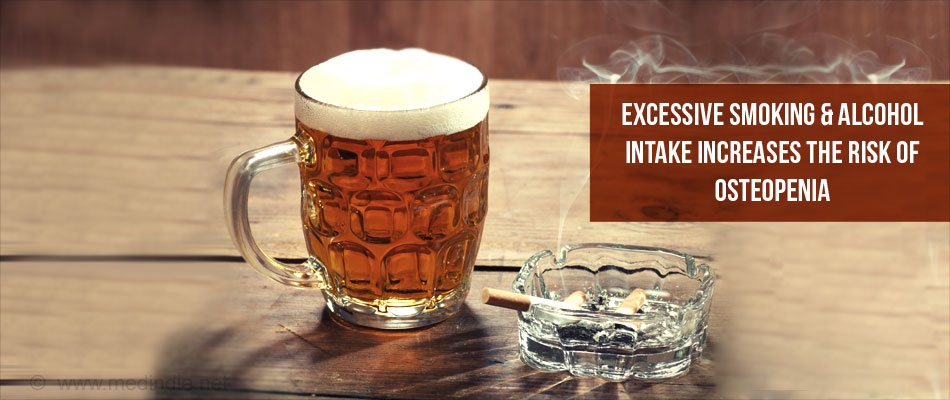
- Osteopenia is one of the three key components of female athlete triad syndrome (amenorrhea and unbalanced eating habits are the others).
- Osteopenia can also be a part of normal aging process.
What are the Symptoms and Signs of Osteopenia?
During the initial stages of osteopenia there will be no symptoms. But with continuous loss of bone, the probability of bone fractures increases. The fractures commonly observed are those of spine, hips and wrists. The symptoms usually observed in people with osteopenia are bone pain, fatigue, stooped posture, loss of height, neck or low back pain and tenderness in long bones.
How Do You Diagnose Osteopenia?
Radiography can be used to diagnose osteopenia; it is usually seen as a visual loss of bone density. A painless and non-invasive scanning procedure such as dual energy X-ray absorptiometry (DEXA) scan can be used to identify decreased bone density and also to diagnose both osteopenia and osteoporosis. The bone mineral density result is then matched with that of people of the similar age and health to find out if the bones are in a good condition or not.
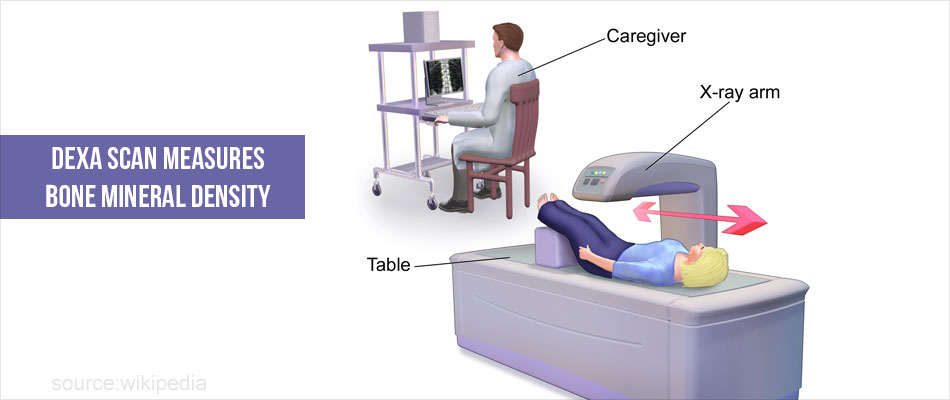
How Do You Treat Osteopenia?
Treatment for osteopenia includes:
- Medications – Medical therapy like bisphosphonates and selective estrogen receptor modulators (SERMs) can be used to manage
osteopenia or osteoporosis. These drugs decelerate the bone breakdown process. Hormone replacement therapy (HRT) and calcitonin are recommended in post-menopausal women to retard bone loss. Certain medicines like steroids may put you at increased risk of osteopenia. - High intake of calcium and vitamin D - Ample amount of calcium and vitamin D are necessary for the body to prevent fragile bones. Calcium performs many important functions in our body; one of them is building strong bones and teeth. In case of calcium deficiency, our body utilizes it from the bones to perform other normal cell functions, which leads to osteopenia or osteoporosis.
We can get calcium from milk, low-fat dairy products, dark green leafy vegetables, salads, canned salmon, canned sardines with bones, fruit juices, cereals and calcium supplements.
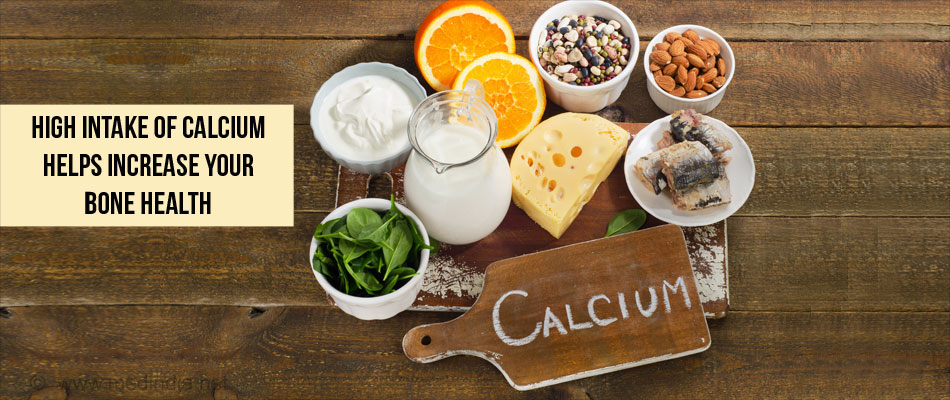
Vitamin D deficiency increases your chances for osteoporotic fracture, especially hip fracture. The human body utilizes vitamin D to absorb calcium. We can get sufficient amount of vitamin D from the early morning sunlight and from certain foods such as cod liver oil, tuna fish, sardines, salmon, eggs and other alternative is vitamin D supplements.
- Changes in Lifestyle - Certain changes in everyday lifestyle can help you to stay away from problems like osteopenia and osteoporosis. Avoid smoking, eat a well-balanced diet, do your exercises regularly and take precautions during any risky physical and sports activities.
- Exercises - Performing regular exercises keeps you fit and stimulates development of healthy bones.
- Strength training exercises - These exercises strengthen your muscles and bones in the arms and upper part of the spine.
- Weight bearing exercises - Exercises like jogging, skipping rope, climbing, swimming, cycling, walking and skiing help in keeping our hips, legs and lower spine bones fit and fine.
How Do You Prevent Osteopenia?
Osteopenia can be prevented by living a healthy lifestyle. It includes:
- Stay away from smoking
- Avoid excessive alcohol intake
- Adequate consumption of calcium and vitamin D
- Doing exercises:
- Weight-bearing exercises; for example push-ups, lifting light weights, dancing and walking.
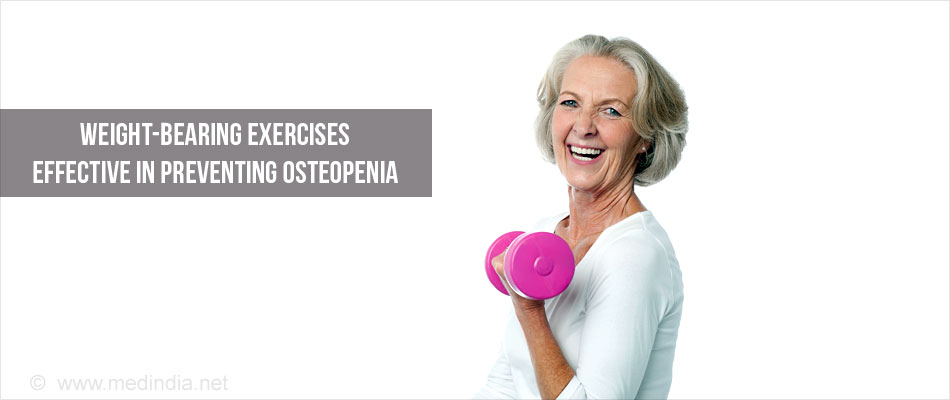
- Resistance exercises - Weight lifting and using resistance bands.
- Consuming a nutritious diet







